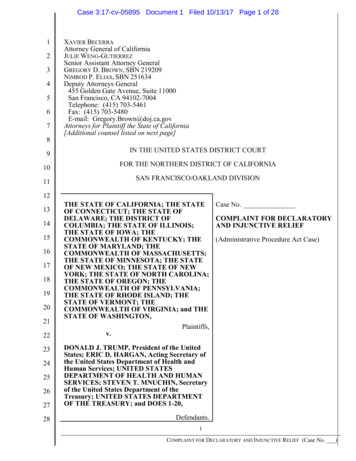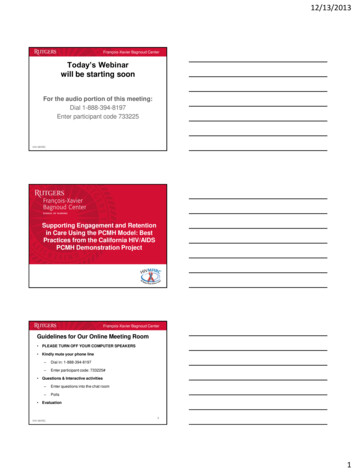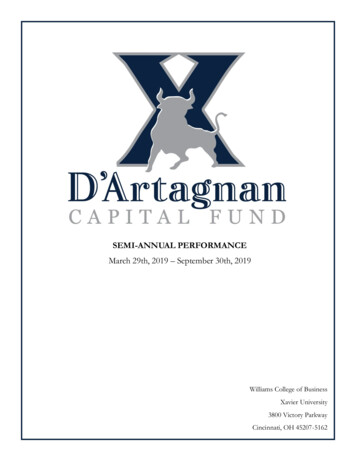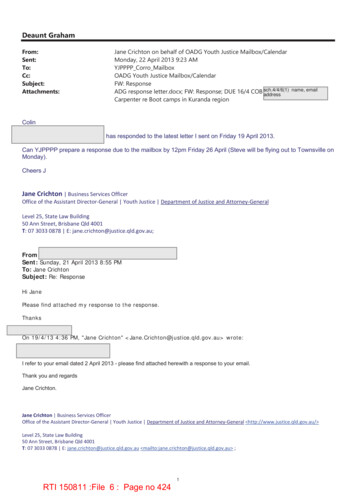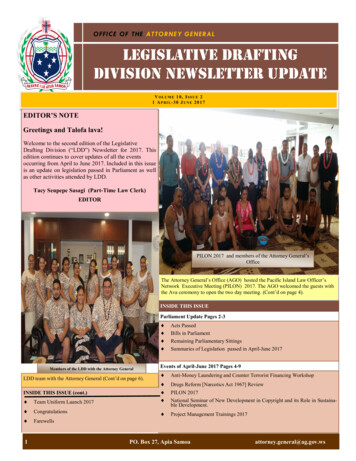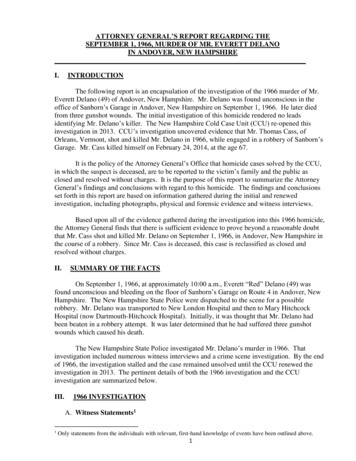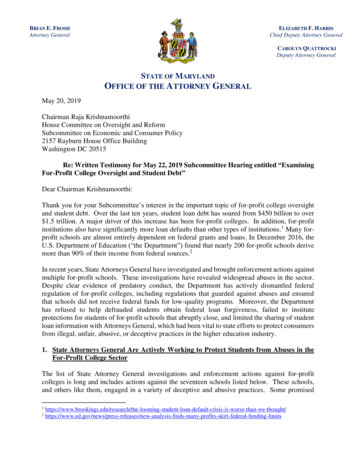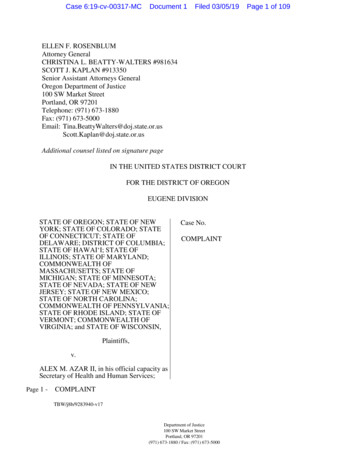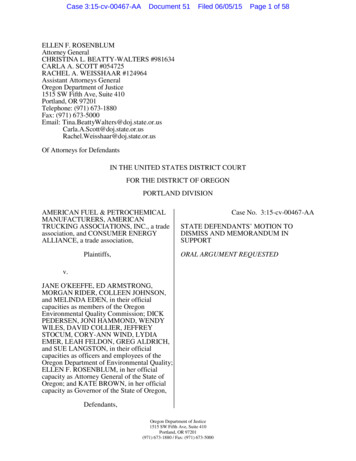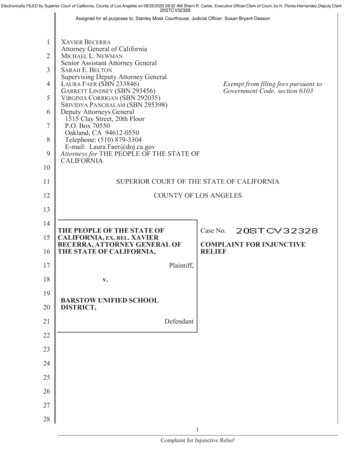
Transcription
Electronically FILED by Superior Court of California, County of Los Angeles on 08/25/2020 08:32 AM Sherri R. Carter, Executive Officer/Clerk of Court, by H. Flores-Hernandez,Deputy Clerk20STCV32328Assigned for all purposes to: Stanley Mosk Courthouse, Judicial Officer: Susan Bryant-Deason12345678910XAVIER BECERRAAttorney General of CaliforniaMICHAEL L. NEWMANSenior Assistant Attorney GeneralSARAH E. BELTONSupervising Deputy Attorney GeneralLAURA FAER (SBN 233846)GARRETT LINDSEY (SBN 293456)VIRGINIA CORRIGAN (SBN 292035)SRIVIDYA PANCHALAM (SBN 295398)Deputy Attorneys General1515 Clay Street, 20th FloorP.O. Box 70550Oakland, CA 94612-0550Telephone: (510) 879-3304E-mail: Laura.Faer@doj.ca.govAttorneys for THE PEOPLE OF THE STATE OFCALIFORNIAExempt from filing fees pursuant toGovernment Code, section 610311SUPERIOR COURT OF THE STATE OF CALIFORNIA12COUNTY OF LOS ANGELES13141516THE PEOPLE OF THE STATE OFCALIFORNIA, EX. REL. XAVIERBECERRA, ATTORNEY GENERAL OFTHE STATE OF CALIFORNIA,192021COMPLAINT FOR INJUNCTIVERELIEFPlaintiff,1718Case No.v.BARSTOW UNIFIED SCHOOLDISTRICT,Defendant222324252627281Complaint for Injunctive Relief
12The People of the State of California, by and through Xavier Becerra, Attorney General ofthe State of California, allege on information and belief as follows:34JURISDICTION AND VENUE1.This Court has jurisdiction over the allegations and subject matter of the People’s5Complaint filed in this action and the parties to this action; venue is proper in this County; and6this Court has jurisdiction to enter this Judgment.789PARTIES2.Plaintiff Xavier Becerra is the Attorney General of the State of California. TheAttorney General is the chief law officer of the state and has the duty to see that the State’s laws10are uniformly and adequately enforced for the protection of public rights and interests. (Cal.11Const., art. V, § 13.)123.Defendant Barstow Unified School District (Defendant or the District) receives state13funds, is a public school district organized and existing under the laws of the State of California,14and is responsible for providing public education to District students.FACTUAL BACKGROUND15164.The right to education is a fundamental right, and students have the right to equal17protection with respect to its provision. (Serrano v. Priest (1971) 5 Cal. 3d 584, 608-09, 616-17.)18The Attorney General has the authority, in his or her sole discretion, to bring claims against a19school district for violation of the California Constitution, Article 1, section 7, or where the20district has failed to ensure that all students, regardless of race, color, national origin, ethnicity, or21disability, are treated equally in all aspects of education. (Educ. Code, §§ 220, 262.3, & 262.4.)225.The Attorney General has the authority, in his or her sole discretion, to bring claims23against a school district for violation of the Government Code section 11135, where the district is24unlawfully denying students full and equal access to the benefits of, or unlawfully subjecting25students to discrimination under, its programs and activities on the basis of, inter alia, race, color,26ancestry, national origin, ethnic group identification, mental disability, physical disability, or27medical condition. (Gov. Code, § 11135(a).) With respect to discrimination based on disability,282Complaint for Injunctive Relief
1the District is subject to the protections and prohibitions contained in state law. (Gov. Code, §211135(b).)3A.45Disproportionate and Exclusionary School Discipline are Associated with NegativeOutcomes.6.Exclusionary school discipline is ineffective in addressing student behavior, is6harmful to students, and often has a disproportionate impact on students of color and students7with disabilities. Greater use of exclusionary school punishments does not help to improve8student behavior either among the students being punished or among the general school9population.1 Instead, evidence shows that being suspended predicts greater rates of criminal1011offending among youth years later, even after accounting for the initial student behaviors.27.Suspension and expulsion put students at greater risk of a host of negative outcomes,12including school failure, grade retention, future unemployment, and future involvement with the13justice system.3 When students miss instructional time for misbehavior, they fall behind14academically and become less engaged in their school and their education.415161718192021222324252627281See Kupchik, The Real School Safety Problem: The Long-Term Consequences of HarshSchool Punishment (2016) pp. 23-27.2Mowen et al., The Effect of School Discipline on Offending Across Time (July 12, 2019)Justice Quarterly.3Rosenbaum, Educational and Criminal Justice Outcomes 12 Years After SchoolSuspension (Jan. 17, 2018) Youth & Soc’y (finding that suspended youth were less likely to havegraduated from college or high school, and were more likely to have been arrested and onprobation); Morris & Brea, The Punishment Gap: School Suspension and Racial Disparities inAchievement (Feb. 1, 2016) 63(1) J. Soc. Probs. 1 (finding that school suspensions account forapproximately one-fifth of black-white differences in school performance; stating that findingssuggest exclusionary school punishment hinders academic growth and contributes to racialdisparities in achievement); Perry & Morris, Suspending Progress: Collateral Consequences ofExclusionary Punishment in Public Schools (Nov. 5, 2014) 79 Am. Soc. Rev. 1067 (finding thathigh levels of exclusionary discipline within schools threaten the academic success of allstudents, including those who have never been suspended); The Council on State Gov’t & Pub.Policy Research Inst. at Tex. A&M Univ., Breaking Schools’ Rules: A Statewide Study on HowSchool Discipline Relates to Students’ Success and Juvenile Justice Involvement (July 2011),(comprehensive longitudinal study in Texas showing that even one out-of-school suspensionmade it five times more likely for a student to drop out and three times more likely for the studentto enter the juvenile justice system within one year, when compared to similar students).4Arcia, Achievement and Enrollment Status of Suspended Students: Outcomes in a LargeMulticultural School District (May 1, 2006) 38 Educ. & Urb. Soc’y 359 (identifying a correlationbetween suspension and school avoidance, diminished educational engagement, and decreasedacademic achievement).3Complaint for Injunctive Relief
18.The harms of overusing exclusionary school punishment extend beyond the2individual students who are punished. Empirical research shows that schools with relatively high3rates of suspensions tend to have worse academic scores for other students, even when4statistically controlling for other predictors of student achievement.559.Studies consistently find that youth of color, particularly African-American youth, are6disproportionately reported for disciplinary incidents and subjected to exclusionary punishments,7even when controlling for student misbehavior.6 The most substantial racial disparities in school8punishment tend to be for more subjectively defined infractions, such as defiance of authority,9disruption, or disorderly conduct, rather than more serious and objectively defined infractions10111213such as fighting.710.Studies have also shown that students with learning and behavioral disabilities are atgreater risk than others of being reported for school discipline.811.Schools throughout California have begun to incorporate positive behavior14intervention and supports, restorative justice practices, and other strategies laid out in the15Education Code to focus on addressing the root causes of student misconduct, to keep students in16schools and learning, and to minimize school removals and involvement with the juvenile justice17system. Schools in California have focused on addressing disparities in discipline to ensure that18certain groups of students are not subjected to disproportionate disciplinary consequences or19treated more harshly as compared to their similarly situated peers.20//21//222324252627285Perry & Morris, Suspending Progress: Collateral Consequences of ExclusionaryPunishment in Public Schools (2014) 79 Am. Soc. Rev. 1067.6U.S. Dep’t of Ed. Office for Civil Rights, Civil Rights Data Collection: Data Snapshot(School Discipline), Issue Brief No. 1 (2014); General Accounting Office (2018) K-12Education: Discipline disparities for black students, boys, and students with disabilities (GAO18-258); Rocque & Paternoster, Understanding the Antecedents of the ‘School-to-Jail’ Link: Therelationship between race and school discipline (2011) 101 The J. of Crim. L. & Criminology633, 653-54.7Skiba et al., Parsing Disciplinary disproportionality: Contributions of infraction,student, and school characteristic to out-of-school suspension and expulsion (2014) 51 Am. Ed.R. J. 640.8Krezmien et al., Suspension, Race, and Disability: Analysis of statewide practices andreporting (2006) 14 J. of Emotional and Behavioral Disorders 217.4Complaint for Injunctive Relief
123B.District Discipline Policies and Practices Result in Different Treatment andDisproportionate Impact.12.In May 2019, the Attorney General’s office began an investigation to determine4whether the District’s policies, procedures, and practices with respect to discipline violated any5California laws, specifically those laws protecting students from discrimination based on a6protected characteristic and other laws that provide for a state constitutional right to education,7other means of correction prior to school removal, and due process protections for students.8913.In April 2020, after a comprehensive investigation of the District’s policies,procedures, and practices focusing on the 2016-2017 school year through the first semester of the102019-2020 school year, the Attorney General’s office found that the District’s policies,11procedures, and practices with respect to discipline discriminated against African-American12students and students with disabilities.1314.In addition, the Attorney General’s office concluded that: (a) the District’s admissions14and enrollment processes for the District’s STEM Academy have denied African-American and15low-income students equal access to educational opportunity on the basis of race and income; (b)16the District has failed in practice to provide legally required other means of correction prior to17issuing suspensions for specified offenses as required by state law; and (c) the District has not18provided a legally compliant response to notice of discrimination, including harassment, on the19basis of protected characteristics for some students.2015.Lastly, the Attorney General’s investigation found that District policies and21procedures were non-compliant with certain aspects of state law that prohibit informal and22undocumented school removals, reduced school day attendance as punishment, and certain23suspensions of Kindergarten through third grade students for disruption and defiance.2416.The Parties have worked cooperatively to agree to a remedial plan that includes25among other things: (1) a five-year term; (2) changes to school discipline policies and practices to26bring them into compliance with state law and to address discrimination and disproportionality in27discipline; (3) ongoing analysis of school discipline and achievement data to address root causes28of discrimination in discipline, consistently implement positive other means of correction, and5Complaint for Injunctive Relief
1develop individualized behavior support plans; (4) implementation of a system of culturally2responsive, multi-tiered supports and interventions; (5) training for staff on manifestation3determination meetings, positive behavior intervention plan creation and implementation, and4reasonable accommodations; (6) appointment of school-site special education liaisons dedicated5to providing support, training, and assistance to parents of students with disabilities during special6education and Section 504 processes; (7) revisions to policies and practices for responding to7discrimination and harassment complaints to comply with state law requirements; and (8) review8of admission and enrollment process for the STEM Academy to reduce significant disparities in9admissions for African-American students. The District has begun to take positive steps to revise10policies and eliminate punitive discipline practices at it school-sites and is committed to11addressing bias and discrimination in all of its forms.1217.The Attorney General’s investigation included a review of the District’s disciplinary13data for the 2016-2017, 2017-2018, and 2018-2019 school years—data collected and14administered by the District. The Attorney General’s review of this data demonstrated that the15District’s use of exclusionary punishment is excessive. The District routinely uses suspension to16respond to relatively minor student behavior, such as disruptive or defiant behavior, and the17majority of reported incidents for which punishments were recorded are for behavior categorized18by the District as disruptive or defiant, including use of vulgar or obscene language.1918.The Attorney General’s review of the District’s own data also demonstrated that20under the District’s discipline policies and practices, African-American students are significantly21and substantially more likely than other students with similar disciplinary histories to be reported22for an incident, to be punished with an out-of-school suspension, and to receive more days of23punishment for similar offenses. African-American elementary school students were 3.5 times24more likely, and African-American middle and high school students were 79 and 78 percent,25respectively, more likely, to be suspended out of school than similarly situated White students.26The rate of days punished for African-American elementary school students was 5.9 times higher27than that of similarly situated White students, and the rate of days punished for disruptive and286Complaint for Injunctive Relief
1defiant behavior for African-American students was 168 percent greater in elementary schools,237.9 percent greater in middle schools, and 54.5 percent greater in high schools.319.The District’s own data demonstrated that African-American students in the District4are also disciplined more often for subjective offenses than other students, with African-American5high school students 72 percent more likely to receive a suspension for disruption and defiance6than similarly situated White students.720.The District’s own data demonstrated that District students with disabilities were also8substantially more likely to be reported for a discipline incident, and were at greater risk of9suspension out of school and for more days than similarly situated students without disabilities.10For example, high school students with disabilities were 2.3 times more likely to be suspended for11a reported incident when compared to students without disabilities. African-American students12with disabilities are at even greater risk of incident reports and suspensions.1321.An analysis of the District’s data found that school punishments in the District result14in a significant loss of instructional time that disproportionately impacts African-American15students. In the District, during 2018-2019, African-American students lost 99.3 days of16instruction in elementary school, 125.8 days of instruction in middle school, and 133.9 days of17instruction in high school per 100 enrolled students. Whereas, during 2018-2019, White students18lost 9.9 days of instruction in elementary school, 32.3 days of instruction in middle school, and1940.6 days of instruction in high school per 100 enrolled students.2022.School punishments in the District have a quantifiable adverse educational impact21beyond the loss of instructional time. In the District, elementary school students who have been22suspended, on average, score 48.8 points lower on math and 50.6 points lower on their English23Language Arts assessment. Similarly, the class rank of suspended middle school students is 24.324percent lower, and the class rank of suspended high school students is 25.9 percent lower, than25students who were not suspended.2623.Statewide data also suggest that the District’s punitive discipline practices have a27particularly acute impact on African-American students, who experience the greatest28disproportionality in discipline. For example, in the 2018-2019 Local Control and Accountability7Complaint for Injunctive Relief
1Plan, the District identified that the academic scores of African-American students were far below2the District average, and below any other racial or ethnic student group in the District.324.In an even more recent Local Control Accountability Plan, the District identified4reduction of its high suspension rate as one of its greatest needs and described factors causing the5high rate, which included “classroom management, attendance rates, student achievement, school6culture and discipline policies.”725.There are comparable effective alternatives that would meet the District’s educational8goals with less burden on African-American students and students with disabilities, such as9incorporating social-emotional learning practices into the curriculum and improving instructional10practices to focus on student engagement, cultural relevance, and opportunities for practice and11feedback.1226.Despite the significant disparities described above and the negative effects thereof,13District administrators do not regularly review disaggregated disciplinary data to identify and14ameliorate disparities. Nor are staff adequately trained on alternative positive behavioral15strategies set forth in state law, resulting in inconsistent implementation of these policies and16inadequate tools to address unequal treatment in discipline and improve school climate and17cultures.18C.1920The District Did Not Adequately Respond to Allegations of Discrimination for SomeStudents.27.The Attorney General’s investigation identified that the District has been on notice of21discrimination, including harassment and bullying that may have subjected some students to a22hostile environment on the basis of protected characteristics, but the District did not provide a23prompt and adequate response. With respect to one matter, the investigation did not identify24evidence that the District had investigated or adequately responded to the allegation of25discrimination or had utilized the required state law Uniform Complaint Procedure process, which26includes a written report of findings and the right to appeal.272828.A review of District data also shows that the District does not regularly issue finalwritten decisions to complainants that include findings of fact, corrective actions, a disposition,8Complaint for Injunctive Relief
1and a right to appeal as required by state law Uniform Complaint Procedures. (Ed. Code, §233315; Cal. Code Regs., tit. 5, § 4610 et seq.) Witness testimony raised concerns that the District3is not consistently providing legally required translation and interpretation services as needed for4parents and guardians raising complaints.5D.6789Important Aspects of District Discipline Policies and Practices Fail to Comply withState Law.29.The Attorney General’s investigation also found that important aspects of theDistrict’s disciplinary policies are inconsistent with state law.30.Several District discipline documents reflect that the District’s policies do not10consistently provide other means of correction prior to suspension, even though required for11certain offenses under state law. In practice as well, the District does not consistently provide12students other legally required means of correction required before suspension. Evidence13reviewed shows that students were most often suspended instea
Assigned for all purposes to: Stanley Mosk Courthouse, Judicial Officer: Susan Bryant-Deason 1 XAVIER BECERRA Attorney General of California 2 MICHAEL L. NEWMAN Senior Assistant Attorney General 3 SARAH E. BELTON Supervising Deputy Attorney General 4 LA
